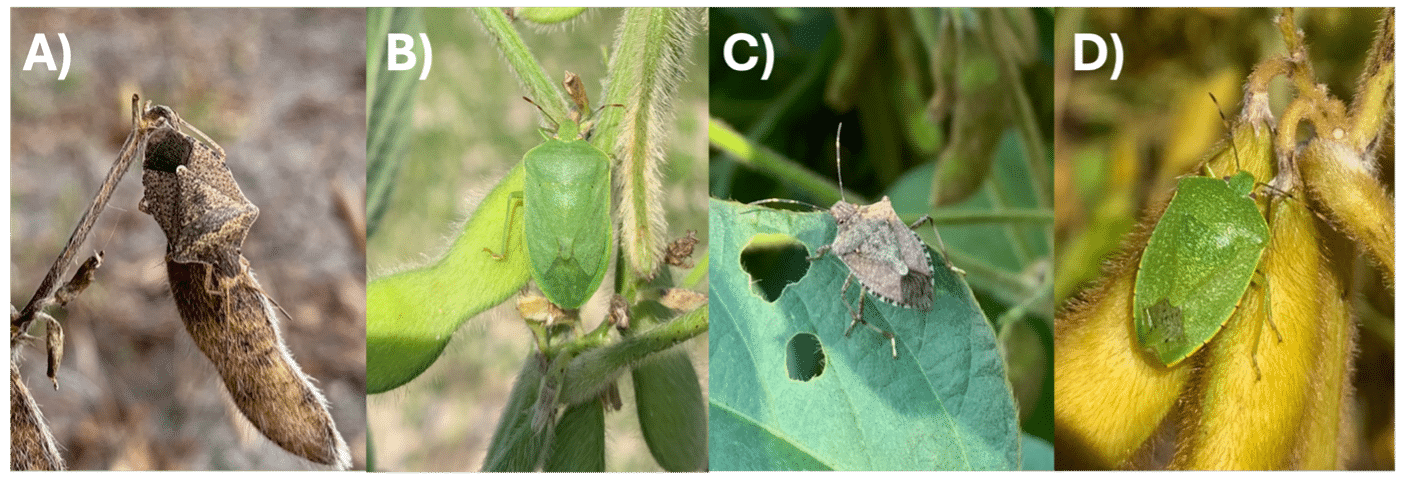Stink bugs are an economically damaging pest of fruit trees, vegetables and row crops such as corn, cotton and soybean. They are a challenge to control due to their piercing-sucking mouthparts, which they use to inject digestive enzymes into plants, liquefying tissues. In soybean crops, stink bugs (Figure 1) are estimated to have cost approximately $300 million in losses from 2020 to 2023 across 18 U.S. states.
 Figure 1. Four yield limiting stink bug species found on NC soybean. A) Euschistus sp., B) Nezara viridula, C) Halyomorpha halys, D) Chinavia hilaris. Photo: Taynara Possebom.
Figure 1. Four yield limiting stink bug species found on NC soybean. A) Euschistus sp., B) Nezara viridula, C) Halyomorpha halys, D) Chinavia hilaris. Photo: Taynara Possebom.
Growers’ typical first step in controlling this pest is to scout stink bugs in the field using a beat cloth or sweep net (Figure 2). If populations reach a defined level (an economic threshold), growers are advised to spray insecticide. However, sampling in this way is time-consuming. A potential alternative is to use pheromone traps – these traps have a lure that attracts stink bugs and enables us to monitor early stink bug presence in the field. Part of my research as a PhD student and FFAR Fellow at NC State University is to field test a variety of pheromone traps to understand their utility for sampling. Specifically, I asked: 1) which trap would catch the most stink bugs; 2) which trap is most reliable; and 3) which trap is most efficient?
 Figure 2. Sweep net sampling method in soybean. Photo: Rebecca Kirkland.
Figure 2. Sweep net sampling method in soybean. Photo: Rebecca Kirkland.
The Field Research
I selected sixty-eight farm fields in Johnston County, NC, for the comparative experiment. I checked traps and scouted those fields twice a month from August to December 2023 and 2024.
I tested seven commercially available pheromone traps (delta Figure 3C, black pyramid Figure IC, yellow pyramid Figure 3H, blue Figure 3D, yellow Figure 3G, white Figure 3E, and clear sticky card Figure 3F) and two types of pheromone lures (single and dual). In collaboration with a company, I also tested a smart trap overtop the delta trap (Figure 3 A and C). This trap had a camera on the top that sent instant photos to a mobile app. These photos were used to train models for identifying stink bug species and to adapt trap types as needed based on our results.
Additionally, in every field, I took one hundred sweeps (a total of 62,900 sweeps across the seasons!) to determine whether stink bug densities were above the recommended spray economic threshold.
 Figure 3. Pheromone traps that I used in my research included: A and C) smart trap overtop the delta trap, B and I) black pyramid trap, D) blue sticky card, E) white sticky card, F) clear sticky card, G) yellow sticky card, and H) yellow pyramid trap. Photos: Rebecca Kirkland and Taynara Possebom.
Figure 3. Pheromone traps that I used in my research included: A and C) smart trap overtop the delta trap, B and I) black pyramid trap, D) blue sticky card, E) white sticky card, F) clear sticky card, G) yellow sticky card, and H) yellow pyramid trap. Photos: Rebecca Kirkland and Taynara Possebom.
Which trap caught the most stink bugs?
- The black pyramid trap (Figure 3 B and I) captured the most stink bugs, followed by the yellow pyramid trap (Figure 3 H). The dual lure attracted more types of stink bug species than the single lure.
Which trap was most reliable?
- Both the delta (Figure 3 A and C) and yellow pyramid (Figure 3 H) traps were the most reliable.
Which trap was most efficient?
- Both the black pyramid (Figure 3B and I) traps and the yellow sticky cards (Figure 3 G) required the least time investment.
My next steps in this project are to compare the economics for individual trap types and to survey soybean producers to understand their perspective about monitoring systems.
I will work closely with soybean producers, industry, extension agents and specialists, while prioritizing communication to develop a bottom-up approach that listens to growers’ needs and refines research questions.
Ultimately, my research will improve scouting efficiency, contributing to food security and growers’ well-being. Additionally, it will generate a more comprehensive understanding of stink bug phenology within cropping systems.
Acknowledgments
I would like to express my gratitude to my Ph.D. supervisor, Dr. Dominic Reisig, and my FFAR mentor, Dr. Teresia Nyoike, for their invaluable guidance and mentorship throughout this journey. I am grateful to Syngenta for their sponsorship, which enabled my participation in the FFAR Fellows Program, and to the Soybean Producers Association and FMC for funding my Ph.D. research project.
Special thanks to Joshua Mayfield for his field assistance and to the extension agents – Tim Britton, Dan Wells, Bryant Spivey and Seth Balance – who came to our rescue when the lab vehicle got stuck in the field. I also extend my appreciation to all members of the Reisig lab for their support.
I am especially grateful to the interns who accompanied me in the field and helped collect data: Ândrea Sagiorato, Brynn Capuano, Carolina Fagundes and Ligiany Reginato – I could not have done it without them!
Finally, I extend my deepest appreciation to the FFAR Fellows Program for supporting my development in leadership, communication and soft skills while enhancing my self-confidence, critical thinking abilities and professional network.